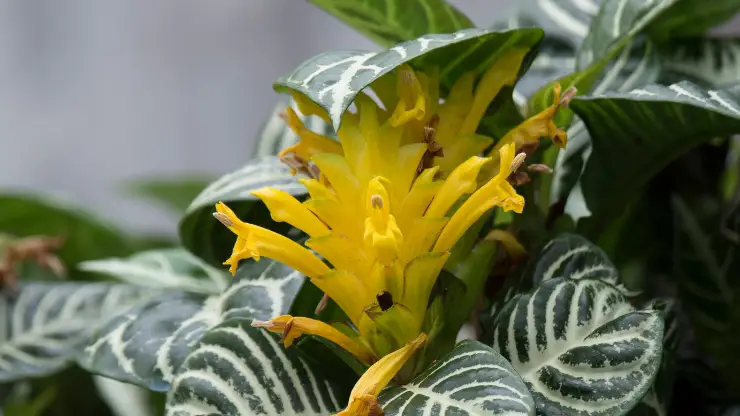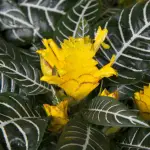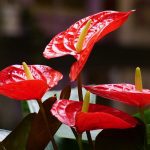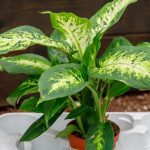
Aphelandra squarrosa, also known as zebra plant or saffron spike, is named for its glossy green leaves marked with bold white veins – similar to a zebra’s stripes. In its tropical home of Brazil, this plant grows into a 4 foot (1.2 meter) tall shrub. As a houseplant, you can expect heights of around 15 to 24 inches (38 to 60 cm).
Although prized for its attractive foliage, zebra plant also produces beautiful flowers when given proper care. A happy plant blooms in late summer to fall, producing delicate yellow flowers that emerge from clusters of yellow bracts. Flowers last several days, and bracts last up to six weeks.
In this post, I’ll cover all aspects of Aphelandra squarrosa care, so you can keep your plant thriving and producing more flowers. I hope you’re up for the challenge!
Aphelandra Squarrosa Care Guidelines
Zebra plant is not easy to grow indoors, and can be difficult to keep alive – much less getting it to flower. I place it in the “challenging to grow” category. But if you can get the conditions just right, you’ll have a gorgeous houseplant for many years. Here’s a run-down of care guidelines:
- WATER: Keep soil constantly moist
- HUMIDITY: Moderate to high
- FEEDING: Every two weeks spring through fall, reduce in winter
- LIGHT: Bright in spring and summer; moderate in fall and winter
- TEMPERATURE: 65 to 80 degrees F (18 – 27 degrees C)
- SAFETY: Non-toxic to cats, dogs, and humans
- DIFFICULTY: Challenging
Keep reading for more detailed information on caring for zebra plant – including potting suggestions, propagation instructions, maintenance, and troubleshooting.
Water
Constant moisture is necessary for good Aphelandra squarrosa care. Never allow the soil to dry out, or your plant will quickly die. Water when the top of the potting medium feels dry to the touch. Getting the water right is a delicate balance, and it might take practice.
Keep soil moist, but never wet or soggy. Too much standing water may lead to root rot. Make sure your soil is well-draining and the planter has drainage holes in the bottom.
Humidity
Aphelandra squarrosa requires moderate to high humidity levels. Mist daily with a spray bottle filled with lukewarm water set to the mist setting. Place the plant on a humidity tray – a shallow tray filled with pebbles and water – to keep humidity levels high. (See my post on how to make a humidity tray for more information.)
You might also want to consider placing a high-quality humidifier in the room with your zebra plant – especially if you live in a dry climate or if your home is centrally heated. Winter air can be very dry indoors. Read a review of my favorite houseplant humidifier or view it directly on Amazon.
Fertilizer
Feed your Aphelandra squarrosa plant once every two weeks in spring through fall with a fertilizer diluted to half strength. In winter, reduce feeding to once every six weeks. My favorite fertilizer for zebra plant is Jack’s Blossom Booster (for more flowers) or Jack’s Houseplant Special (for foliage), but you can use any high-quality houseplant fertilizer you like.
I also recommend leaching the pot twice during the summer months to flush out excess fertilizer salts. Here’s what to do:
- Place your plant in a sink or tub where it can easily drain.
- Water thoroughly with plenty of clean, tepid water.
- Allow excess water to drip out through the drainage holes for at least 30 minutes, then repeat by drenching the pots again.
- Repeat one final time (for a total of three times) to remove any built up fertilizer salts.
This is a good thing to do for all your houseplants once every 8 weeks or so, but it’s particularly important for zebra plant.
Zebra Plant Light Requirements
An important part of Aphelandra squarrosa care is making sure it gets the right amount of light at the right time. This is part of what makes this plant tricky to grow – and it may take a few tries to figure it out. For the best results, follow this schedule:
- Late Spring: Place in bright light from a south- or west-facing window (but not in direct sunlight), or move to a shady porch or patio outdoors. Hang sheer curtains to filter direct sun and avoid burning leaves if necessary. When exposed to bright light for 3 months, your zebra plant will bloom in the fall, it’s natural flowering season.
- Late Fall or Early Winter: After flowers fade and the bracts deteriorate, move to a cool room that receives indirect light for at least two months (or until late spring). An east- or north-facing window is a good location for the resting period.
Unlike some other flowering houseplants, zebra plant’s blooms are triggered by light intensity rather than day length. So keeping it in bright light for three months, beginning in late spring, should trigger fall flowers. If your plant doesn’t bloom, you didn’t provide enough bright light.

Temperature
Aphelandra squarrosa prefers warm temperatures of 65 to 85 degrees F (18 – 29 degrees C). During the day, higher temperatures of around 75 to 85 degrees F (24 to 29 degrees C) encourage better growth. At night, it can tolerate temperatures on the lower end.
Keep temperatures towards the lower end during the resting period after flowering as well. Never allow the temperature to drop below 60 degrees F (15 degrees C) – especially in the winter. Long periods of cold temperatures can cause severe damage and may kill zebra plant.
Potting
Re-pot your Aphelandra plant once a year in spring until your plant is as big as you want it to get. I recommend re-potting just before you move it to a brighter location after the rest period. Zebra plant likes being slightly root-bound, so don’t choose a pot that’s more than 2 inches larger than its current container.
The best potting mix for zebra plant is an African violet mix or any mix that’s formulated for indoor flowering plants. I really like this mix by Black Gold. It’s the one I currently use for my blooming houseplants, and I’ve had good success with it. But as long as you use a high-quality African violet mix, you should be fine.
Propagation
The best way to propagate Aphelandra squarrosa is from stem tip cuttings. I recommend propagating in spring at the same time you’re re-potting and before moving the plant to a bright location after the rest period. Here’s what to do:
- Cut a 4-inch (10-cm) piece of stem from a healthy area of the parent plant. Use pruning shears and make the cut at a 45-degree angle.
- Remove leaves from the lower one-third of the cutting. Dip the cut end into a rooting hormone powder. Tap to remove any excess from the end of the cutting.
- Insert the bottom one-third of the cutting into moist seed starting potting mix.
- Cover with plastic and place in indirect light. Avoid direct sun. Keep the potting mix moist (but not wet), and transplant into regular potting soil after 4 – 6 weeks.
Maintenance
After zebra plant’s bracts deteriorate – usually about 4 to 6 weeks after they appear – clip them off at the base. Then, move the plant to a cool room to rest for at least two months before moving back to a bright place in late spring (see Light section above for more information).
Wipe leaves often with a damp cloth to keep them glossy and free of dust. (See my post on how to clean your houseplant’s leaves for more information.) Do not use leaf-shine products on zebra plant – or any of your houseplants for that matter.
Troubleshooting
Here are some common problems indoor gardeners often have with Aphelandra squarrosa and how to fix them.
- Zebra Plant Leaves Curling – If your zebra plant leaves become crinkled or curled, this means it’s receiving too much light. Move to shadier location or filter light from a window by hanging sheer curtains. This plant cannot tolerate direct sun, but needs bright, indirect light during the late spring and early summer to induce blooming.
- Leaves Wilting – If your zebra plant leaves are wilting, this is most likely because the soil is too dry. Aphelandra squarrosa requires constant moisture, which can be difficult to achieve in the summer. Water thoroughly and make sure the soil stays moist at all times. If your plant is severely dehydrated, see my post on how to revive under watered plants.
- Leaves Dropping Off – If you notice lower leaves are wilting and dropping off, this can be due to too much or too little water, or excessive fertilizer. Maintain constant soil moisture, but don’t allow the soil to become wet or soggy (this is a delicate balance). Leach pots using instructions in the Fertilizer section above at least every eight weeks.
Related: Why is My Zebra Plant Dying? (Causes and Solutions)

Related Questions
Here are some commonly asked questions related to Aphelandra squarrosa care that you might find helpful (and my answers to them).
How much light do zebra plants need? In the late spring through fall, zebra plants need lots of bright, indirect light. A south- or west-facing window filtered by sheer curtains is an ideal location. After flowers fade and bracts deteriorate (in late fall or early winter), move the plant to an area that receives moderate light until late spring. A north- or east-facing window is a good location for this resting period.
How often should you water zebra plant? Water any time the top of the potting medium dries out. If the soil feels dry to you, water the plant thoroughly. Zebra plant needs soil to be consistently moist, so never let it dry out completely. But also avoid watering too much so the soil becomes wet and soggy.
Should I cut the flower off my zebra plant? If the flower has faded and is starting to deteriorate or look unattractive, yes. You can cut it off. Use sharp, sanitized pruning shears to remove spent flowers. The bracts should also be snipped off when they begin to deteriorate – which usually takes about 4 to 6 weeks after they first appear.
Why are my zebra plant’s leaves turning brown? Brown leaves are usually caused by low humidity and/or not enough water. Increase humidity near your plant by daily misting, placing on a humidity tray, or placing a humidifier in the room. Avoid blasts of hot, dry air from heating vents, and water thoroughly when the top 1 inch of soil dries out.
Where to Buy Aphelandra Squarrosa
Aphelandra squarrosa is a popular flowering plant and can usually be found for sale at local nurseries and big box stores with garden centers in early spring. I just recently saw some beautiful flowering zebra plants at my local Lowe’s.
If for some reason you can’t find one locally, I recommend checking the listings on Etsy. I love buying my more exotic and hard-to-find houseplants from small growers on Etsy. The smaller growers usually have higher quality plants (compared to large corporate nurseries), and they seem to care more about their customers.
Click here to see the current listings for Aphelandra on Etsy. Good luck and happy growing!




